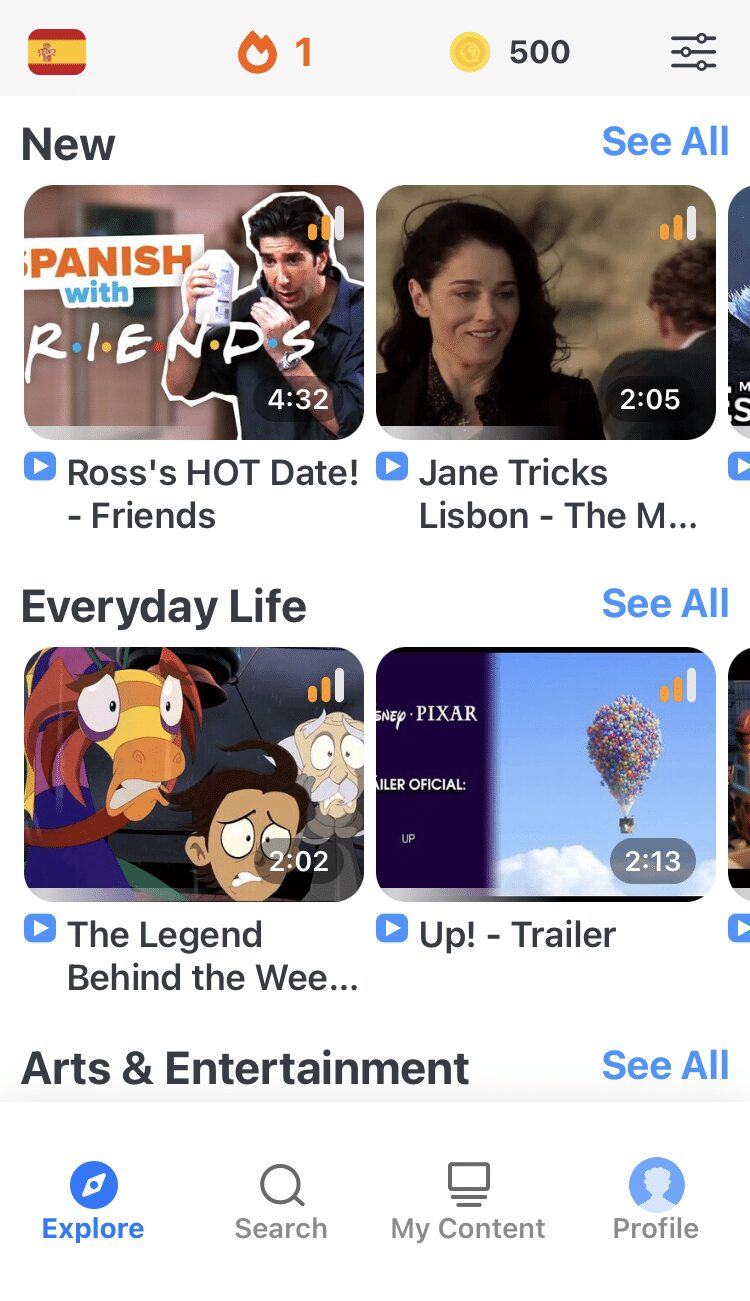Contents
- 1. Do Regular Flashcard Reviews
- 2. Be Active on X (Twitter) or Instagram
- 3. Watch Movies and TV Shows Intentionally
- 4. Explore Foreign Podcasts and Music
- 5. Stay Updated with News
- 6. Set Up Language Exchanges
- 7. Work with a Tutor
- 8. Participate in Chat Rooms
- 9. Check Out Foreign Vloggers
- 10. Write a Blurb About Your Day
- 11. Start a Practice Group with Other Learners
- 12. Read Wikipedia in Another Language
- And One More Thing...
How to Practice a Language with 12 Effective Methods

Practicing a language every day will work wonders for your progress, though it can be difficult to keep thinking up new ways to do so.
As a team of avid language learners (with 10+ languages between us), we’ve compiled 12 activities that are both effective and convenient, and they’ll allow you to slip in some daily language practice even on the busiest of days. Plus, they’re doable from anywhere, as long as you have your phone or an internet connection.
Download: This blog post is available as a convenient and portable PDF that you can take anywhere. Click here to get a copy. (Download)
1. Do Regular Flashcard Reviews
Whenever you learn a new word, make sure you write it down on a flashcard along with a description that you’ll understand and remember. Make it as quirky as you want. Use colors and images if you need to.
You can also do it the digital way and try out flashcard apps like Anki or Memrise.
While you’re waiting for your coffee to brew or your lunch to heat up in the microwave, run through a few of these flashcards and test your memory.
Here’s another tip—keep flashcards grouped in batches that focus on a particular topic. This lets you create connections through similar vocabulary
2. Be Active on X (Twitter) or Instagram
There are two social media platforms that stand out for learning languages: X (formerly Twitter) and Instagram.
X is unique in that when you can default to tweets in your target language by changing the settings. This way, you’ll be constantly learning new online slang and abbreviations—lots of snippets of natural language.
Don’t forget to check out those trending hashtags on the home page! The short format makes reading easier, especially if you’re a beginner who wants practice with quick sentences.
Instagram also works great because it’s primarily visual with only short text. If you’re a beginner, you might follow accounts specifically for language students. To find one, search hashtags like #learnArabic, #learnChinese and #learnFrench.
3. Watch Movies and TV Shows Intentionally
Binging TV and watching movies are undeniably fun activities for language learning, especially if you’re at an intermediate level or above.
Netflix offers an abundance of streaming options in most popular languages. Plus, it has its own original foreign language content that you can’t get anywhere else, like the popular Spanish series “Las chicas del cable” (Cable Girls).
To get the most out of Netflix, you can even use FluentU’s language learning Chrome extension, which breaks down each word in the subtitles for you.
If you already subscribe to Amazon Prime, you have access to some free foreign language programming via Amazon Prime Video. Hulu has some options too for language learners.
4. Explore Foreign Podcasts and Music
Thanks to the internet, you have easy access to tons of music in your target language. Popular services like Spotify and iHeartRadio offer some international fare that will fit the bill.
Online radio is another fun, easy option. Services like AccuRadio offer a nice array of world music, while free online services like TuneIn let you filter by language and/or country.
Aside from music, podcasts are also one of the best ways to improve your listening comprehension and pick up on intonation. Lots of language learning podcasts have a transcript and tasks to go alongside them. Notes in Spanish, for example, provides worksheets for every episode.
Not sure which podcasts are worth your time? No worries! We’ve already gone through and found the best for you in several target languages, including English, Japanese, Spanish, Portuguese and French.
5. Stay Updated with News
With news in your target language, you can read about all sorts of topics, from serious situations around the world to who was the best-dressed at the Oscars.
We’ve put together some great guides for using the news to learn Chinese, English, French, German and other languages.
Even if you’re a beginner, there are also news written for language learners—for example, news with simpler vocabulary or slow audio.
Newspapers tend to use simpler language, but remember to still write down any words and phrases you’re not sure about (or save them as flashcards).
6. Set Up Language Exchanges
You can easily talk to native speakers by logging onto language exchange apps! Use the advanced search features so you have a higher chance of being able to relate to the person. Consider gender, family status, age, hobbies—things you can find on their profile.
When you’re still starting out, I recommend simply getting to know one another. Then, as you dive deeper, ask for constant corrections, as folks can be polite and overlook some errors.
Ask lots of questions, but remember that grammar might not be the easiest for your partner to discuss, so entrenched are they in their own native language. Ask for resource ideas like movies, books, comics and TV shows. Share jokes with each other to acquire a new sense of humor!
7. Work with a Tutor

While not free, an online tutor can advance your language skills like nothing else in this mortal coil. You can get a real-life tutor by checking local universities or venturing online and hiring one from italki or Verbling.
When you find a tutor you think you might like, send questions before you meet. Really explain in detail what your issues are and what your goals are, and where you see yourself going. Then make sure you meet consistently, or decide on a particular number of lessons.
In particular, grammar questions and issues are great to bring up with a tutor. A professional teacher is much better equipped to explain grammar than a language partner (although language partners can be great in letting you know what “sounds right”).
8. Participate in Chat Rooms
I personally love chat rooms because text chatting with strangers gives you real time language practice if you’re not quite ready to take on speaking just yet.
You can easily find chat rooms in your target language by joining Discord and looking for servers there. Enter one of your interests as a tag, whether it’s games, gardening, politics or craft, then you can filter by language.
It’ll take some hunting, but you can also get good results by translating “chat room” into your L2, and Googling that along with your hobby/interest of choice.
If forums aren’t your style, many online multiplayer games have that same real-time text that we’re after. Think World of Warcraft or League of Legends. You jump right in, and players converse in real time.
9. Check Out Foreign Vloggers
To learn a language on YouTube, follow vloggers who use your target language. Whenever your favorite vlogger posts a new video, just watch and enjoy to get a little language practice.
If you want to up the learning ante, you might even try interacting with other viewers in the comments section.
You can also use a tool like Channel Crawler to search YouTube channels by language. This even allows you to filter by country or sort YouTube Channels by number of subscribers to get the most popular ones.
If you enjoy learning through videos, then you can also practice with FluentU. This combines videos with study tools like flashcards and interactive subtitles, so you can focus easily on learning the language while watching.
10. Write a Blurb About Your Day
While you’re waiting in line in a shop or waiting for something to print, grab a post-it note or open up a “notes” app on your phone if you have one, and jot down a few words about your day.
Simple sentences are fine, just like if you were writing a to-do list or, if you have more time to write, feel free to crank out a full-page essay on what you’ve had for lunch.
This limbers up your writing skills in your target language and encourages you to think about simple things and actions in the foreign language.
11. Start a Practice Group with Other Learners
If your friends or coworkers are learning the same language as you, make good use of them!
Plan to meet at a certain point throughout the day for 10 minutes and commit to only speaking in your target language.
You can take this one step further, too, and test each other with flashcards, do two-player language learning games or discuss a podcast you’d all planned to listen to the night before.
Make sure to set tasks for each meeting so that there’s some kind of focus and you’re not tempted to simply chat about other stuff.
12. Read Wikipedia in Another Language
Ever fallen into a Wikihole? Sometimes, it’s hard not to. You open one page you’re interested in and soon you’re flipping through 20 tabs of related content.
Thankfully, there are lots of versions of Wikipedia in different languages. The next time you want to look up something on Wikipedia, try doing it in your target language.
Since Wikipedia’s user-generated, it’s important to remember that it won’t always be accurate. However, if you see something that isn’t accurate or want to contribute additional material, you can also practice your language skills by contributing content yourself!
How about it? Think you have a spare 10 minutes free every day? Not anymore! I challenge you to choose at least three of these activities and incorporate them into your routine in the coming week.
I bet you’ll be surprised at how well short, sharp bursts of daily language practice work for you!
Download: This blog post is available as a convenient and portable PDF that you can take anywhere. Click here to get a copy. (Download)
And One More Thing...
If you dig the idea of learning on your own time from the comfort of your smart device with real-life authentic language content, you'll love using FluentU.
With FluentU, you'll learn real languages—as they're spoken by native speakers. FluentU has a wide variety of videos as you can see here:
With FluentU's Chrome extension, you can bring interactive learning tools directly to YouTube or Netflix, and even import your favorite YouTube videos directly into your FluentU account.
FluentU has interactive captions that let you tap on any word to see an image, definition, audio and useful examples. Now native language content is within reach with interactive transcripts.
Didn't catch something? Go back and listen again. Missed a word? Hover your mouse over the subtitles to instantly view definitions.
You can learn all the vocabulary in any video with FluentU's "learn mode." Swipe left or right to see more examples for the word you’re learning.
And FluentU always keeps track of vocabulary that you’re learning. It gives you extra practice with difficult words—and reminds you when it’s time to review what you’ve learned. You get a truly personalized experience.
Start using the FluentU website on your computer or tablet or, better yet, download the FluentU app from the iTunes or Google Play store. Click here to take advantage of our current sale! (Expires at the end of this month.)















